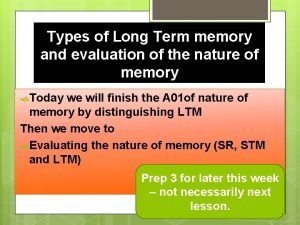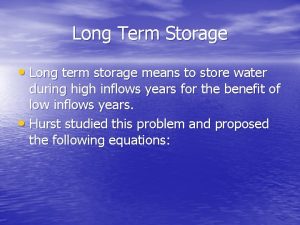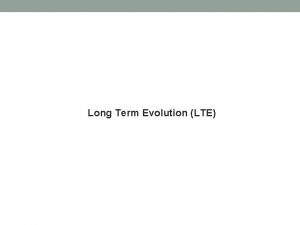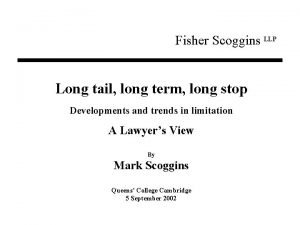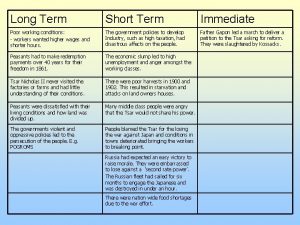Long term changes to P 3 P Long
























- Slides: 24

Long term changes to P 3 P Long Term Future of P 3 P Workshop Giles Hogben Joint Research Centre European Commission 1

Summary • MAIN GOAL: Expanding the scope of P 3 P • Preference Exchange Language + Identity Management • Against Compact Policies • Consent • Enterprise and Audit Trails • Data Typing Schema • Ontology and Useability 2

Preference Exchange Language – Why do we need one? 3

Preference Exchange Language – Why do we need one? • Configuring preferences is too complex and time consuming for users. • But defaults should be open to experts and 3 rd parties e. g. law enforcement. • Preferences should be able to take account of e. g. cultural diversity • For “sticky” preference sets and moving between browsers. 4

What went wrong with APPEL? • Syntax too quirky • Logic unintuitive (lots of ways to say the same thing) • Logically ambiguous (see paper). • No Involvement of implementers. 5

Appel: What can we do? • Use Xpath for rule “Body” • Example <appel: RULE behavior="block" prompt="yes" promptmsg="Resource will use your home info beyond current purpose "> <appel: MATCHQUERY query="//DATA[not(substring(@ref, 'dynamic. clickstream. clientip. fullip ') or substring(@ref, ‘ dynamic. http. useragent'))]“ querylangauge="XPATH"> </appel: RULE> (block all sites which collect any information beyond clickstream data. ) • Advantages 6 – – Standards compliant Widely known by developers Flexible and General Uses optimised systems

Appel: What can we do? • Drop ordering constraint – all rules fire with rules for what to do on conflict? Needs further research… 7

Appel: What can we do? • Link to identity management systems – Greater range of behaviors – Link to mechanism for information request (link to Xforms) – P 3 P cannot provide a data request because it is a policy language (general statements). • Ability to associate P 3 P policies at the level of the form field (we will do x with your email and y with your medical details) 8

Appel: What can we do? Involve implementers 9

Against Compact Policies • “A site MUST honor a compact policy for a given URI in any case (even when the full policy referenced in the policy reference file for that URI does not correspond … to the compact policy itself). “ P 3 P 1. 0 specification • BUT compact policies only “provide hints” to user agents to enable the user agent • Rely on a handful of tokens to summarize a full policy so necessarily corrupt the meaning of many policies. • In practice, compact policies have been used to replace full policies. 10

Why did we think needed Compact Policies? • Speed of evaluation? - not a significant problem. • Saving on roundtrips? - with caching not a significant problem. • Ease of expression? - not an issue due to policy GUIs. 11

Solution • Get rid of them! • Publish guidelines on how to reduce roundtrips. • Publish fast matching algorithm guidelines. 12

Data Typing Schema • We now have XML Schema version of base data schema and xslt’s to make the relevant conversions. BUT 1. • No way to simply specify whether a data type is personally identifiable. 13

Data Typing Schema BUT 2. • Semantics is unnecessarily confused and complex: – 2 orthogonal systems: categories and data elements. – No formal semantics. E. g does “user” mean users or does it mean the class of data about users. This seems trivial but without clear semantics, its useage is restricted. – Categories are ambiguous (not disjoint) e. g. political/government). it is possible to write inconsistent descriptions (e. g. nonidentifiable + physical category? ? ? ) – Other small points of detail – see paper. 14

Enterprise Audit Trails and P 3 P: Why? • Crucial issue for P 3 P 1. 0: “That’s what they say – but what if they don’t do what they say? ” • Audit trails are a way of automatically checking on actual practices. • Accountability mechanism. 15

Enterprise Privacy Audit architecture Data Flow Ontology Privacy Layer Rules & Rule Engine GUI Security Layer Privacy Based Access Policies Audit Log 16 Security Policies

Requirements from P 3 P • Adaptation of semantics for privacy access profiles (APPEL+). • Adaptation of semantics for privacycrucial event trail logs. • Mapping tools for aligning internal data models with P 3 P standardised semantics. • Rule based system for analysing logs. 17

Why Consent in P 3 P? LAW: • The EU's Article 29 working group. "Internet users must have a real possibility of objecting on-line by clicking a box“ • The need to prove that consent has been collected is increasingly important. 18

Why consent in P 3 P? ARCHITECTURE: • P 3 P’s is always going to be at the exact point in the system where the user is deciding whether to submit data. • Works cross-context (e. g. AMI – smart coffee cups etc…) – not just HTML forms. • With P 3 P, consent could be collected in any situation where privacy policies are provided (assuming we go beyond HTTP) 19

How to apply a consent mechanism in P 3 P: consent request • Semantics for requesting consent attached to the policy for an information request: e. g. <DATA ref="user. home-info"> <CONSENTREQUEST method="httpheader“ headername="consent 1"> <DATAREQUIRED certificate="X. 509" algotrithmtype="RSA“ minkeylength="128"> I agree that my data in this form will be published on the internet. </DATAREQUIRED> </CONSENTREQUEST> <DATA/> 20

How to apply a consent mechanism in P 3 P: structure of message Structure of message: • Using a proposed RDF ontology version of P 3 P, we could give some semantics to the consent messages. E. g. "I (data subject) agree that the information transferred in this request may be received by third parties. " (ontological terms underlined) 21

Ontology of P 3 P • Current semantics of P 3 P Based around the policy • Predicates key to flexibility Currently missing – “Information” – “Transfers” (no predicates at all) – “Relates to” 22

Revised ontology of P 3 P: Why • Allows greater flexibility of expression and uses for P 3 P. • Greater legal accountability. • More flexibility in translation between different user-groups. • User translations based on situational testing. 23

More information • Ontologies for Privacy – http: //pronto. jrc. it • P 3 P proxy http: //p 3 p. jrc. it • Questions ? 24
 Short, medium and long term planning in education
Short, medium and long term planning in education Long term liabilities
Long term liabilities Long term memory vs short term memory
Long term memory vs short term memory Long term goal
Long term goal Short term and long term human resource planning
Short term and long term human resource planning Short term and long term cash forecasting
Short term and long term cash forecasting Difference between long term and short term liabilities
Difference between long term and short term liabilities Elizabeth mulroney
Elizabeth mulroney Physical changes examples
Physical changes examples Long and short
Long and short Once upon a time there lived an old man
Once upon a time there lived an old man Colpa aurea
Colpa aurea Minterm and maxterm
Minterm and maxterm Position-to-term
Position-to-term Term to term rule example
Term to term rule example Term-to-term rule
Term-to-term rule Term to term rule
Term to term rule Cubic sequence
Cubic sequence Long-term debt preferred stock and common stock
Long-term debt preferred stock and common stock Evaluation of types of long term memory
Evaluation of types of long term memory Tbi long term servival after traumatic
Tbi long term servival after traumatic Long term storage and retrieval
Long term storage and retrieval What is altcs
What is altcs Long-term side effects of tubal ligation
Long-term side effects of tubal ligation Other long term assets
Other long term assets



















